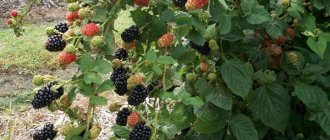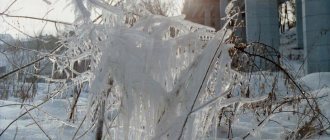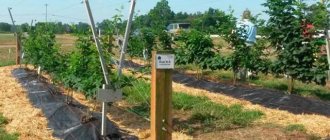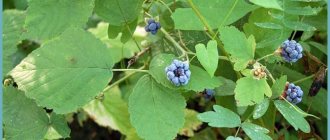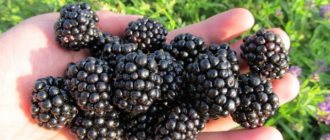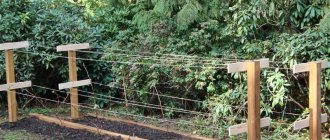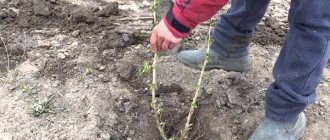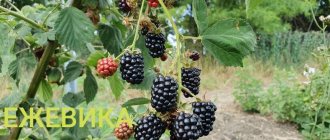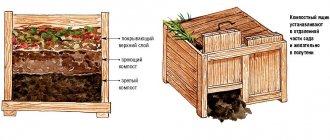Features of autumn planting blackberries
Autumn transplanting of young blackberry bushes into open ground is practiced in areas where autumn is long and warm. The crop does not tolerate low temperatures; there is a risk of freezing of immature young plants.
When can I replant?
If frosts down to –20°C are expected in winter, then even frost-resistant varieties are covered for the cold period after replanting in the fall.
Did you know? The British have many superstitious legends associated with blackberries. For example, in England it is believed that a person who picks berries after October 11 will be desecrated - supposedly on this day the devil himself hunts for blackberries.
It is important to have time to plant seedlings a month before the arrival of the first serious frosts. The optimal time for this procedure will be the beginning of September - mid-October, when temperatures fluctuate between +11...+25°C.
In this case, the transplanted bush or cutting will have enough time to take root and adapt to new conditions before the onset of frost.
Advantages of autumn transplantation
- Many gardeners prefer autumn replanting, citing the following advantages:
- In autumn it is easier than in spring to provide future plantings with the necessary conditions, the most important of which is warm soil. In addition, it is recommended to free the soil from weeds and fertilize it in the autumn months.
- If young bushes transplanted in the fall survive the first winter without problems, in subsequent years they will delight you with their resistance to weather conditions and resistance to illnesses.
- In the autumn months the sun is not as hot as in the summer months, so the bushes will feel more comfortable.
It will also be useful for you to learn about the rules for replanting berry bushes such as raspberries.
Landing dates
The exact time for planting blackberry bushes greatly depends on the local climate. The main thing is to place the plant in the ground 20–30 days before the onset of real cold weather. The seedling must have time to take root well in its new location.
Blackberry seedlings must have time to take root before the start of winter.
In northern regions with harsh climatic conditions, planting is carried out from the end of September until the first days of October. The mild, warm climate of the southern regions makes it possible to postpone this period until November and even mid-December.
A blackberry bush planted in autumn develops its root system until frost, when the soil temperature drops to -4 °C.
Video: when to plant blackberries
Preparing for transplant
There are subtleties in planting blackberries in the autumn. Particular attention should be paid to the preparatory stage.
Selection and preparation of a site
It is recommended to place blackberry seedlings in an area illuminated by sunlight (but the sun should not be scorching) and protected from the wind. In partial shade and shade there is a threat of late ripening of berries, reduced frost resistance and deterioration in the quality of the crop.
And exposure to cold winds will lead to injury to leaves and berries and interfere with pollination. The soil should be moderately moist, since the plant will not perform well in a waterlogged or flooded area.
Planting scheme
The planting method depends directly on the number of shoots that the bush produces.
At a high level of shoot formation, the tape planting method is practiced. Each seedling is planted in a separate hole in a row, the distance between them is approximately 1 m. A distance of 2 to 2.5 m is maintained between rows.
Important! Blackberries produce many shoots, so it is important to maintain a distance of at least 1 m from the berry garden to buildings or fences.
When the level of shoot formation is low, an alternative bush method is used. Several young plants are placed in one recess (the optimal distance between them is slightly more than 1.5 m).
Pit preparation
Due to the fact that the root system of blackberries lies relatively deep, the soil is loosened to a depth of 0.5 m.
Before the autumn planting of seedlings, it is recommended to fertilize the land plot. Add approximately 5 kg of compost or manure, up to 150 g of superphosphate and three times less potassium fertilizer into each hole.
Nutrients must be mixed with the soil so that the roots of the seedlings do not come into contact with them.
Planting technology: step-by-step instructions
Planting blackberries in the fall from planting material in pots is quite simple. To do this, you must follow the following algorithm:
- Remove the plant from the pot. If a seedling grows in an organic pot, which will then rot in the ground, then there is no need to pull it out. To easily remove the plant from an inorganic pot, you need to slightly moisten the soil. With sufficient moisture, the earthen lump will not crumble or soften, and will easily pull away from the walls.
- Dig a hole to a depth of 15 cm more than the lump with the measles system. The dimensions of the hole are approximately 30x30 cm.
- Organic fertilizers are placed at the bottom in a layer of 10-12 cm. Mix well with the soil.
- The plant itself is placed in the hole. Holding it with one hand, bury the hole with the other hand, compacting the soil.
- The plant should be watered. The earth will begin to sink, filling all the voids and large holes.
- Completely bury the hole, while the seedling's growth bud should be placed in the soil to a depth of 2-3 cm.
- Water the plant again.
- Mulch the soil around the sprout. Peat, straw, sawdust, wood chips or grass can be used as mulch.
Mulching will keep the soil moist so you won't need to water it often. In addition, organic mulch is a natural fertilizer.
If seedlings with an open root system are used for planting, then you should be as careful as possible with them. The plant is placed in a hole on soil with fertilizers, and its roots are carefully straightened. The roots are gradually covered with soil and lightly pressed with the palm of your hand to the ground. In the future, the plants should also be watered and the soil mulched.
Choosing the right seedling
It is advisable to purchase planting material in special nurseries, where various forms of garden and remontant blackberries are presented.
The remontant variety receives more positive reviews - its fruiting is more extended, and its resistance to climatic conditions and diseases is much higher.
As for the level of branch formation, from this point of view it is better to give preference to annual specimens with several shoots, the diameter of which is more than 0.5 cm.
Also pay attention to the rhizome - it should look healthy, without signs of rotting. An eye should already be formed on it. An hour before rooting, the roots can be kept in a solution of 1 liter of water and 1 teaspoon of 3% hydrogen peroxide.
Post-landing work
Caring for a plant involves performing step-by-step measures:
- Clothing for caring for the plant should be as tight as possible. Blackberries with thorns will bring a lot of unpleasant sensations when working without gloves.
- At the end of spring or beginning of summer, it is important to properly trim the bush. Young canes are fixed on one side, fruiting ones on the other.
- Caring for blackberries involves getting rid of weeds.
- Controlling humidity levels is an extremely important aspect of a healthy plant.
- Seasonal feeding will help improve the formation of green mass and stimulate the formation of a large number of berries. In spring, organic additives are added to the soil. In autumn it is recommended to add potassium.
Proper planting of blackberries
Timely fertilization of the soil will allow the plant not only to withstand winter frosts more steadfastly, but also to significantly increase the fruiting period.
Garden blackberry is a very picky plant. Reproduction and planting of the crop will not cause any problems even for an inexperienced summer resident. Choosing high-quality planting material will ensure a large harvest and a minimum of problems. Compliance with the rules of agricultural technology and care will also lead to a positive result. It is important not to skimp on fertilizers, without which not a single plant can exist normally.
Watering and caring for transplanted plants
The soil under the berry garden must be periodically watered and loosened. Blackberries have a powerful rhizome, so the bushes do not need abundant irrigation. During the dry season, watering is carried out once a week until frost sets in.
After transplanting blackberries, do not rush to fertilize the plant, give it time to take root. It would not be superfluous to carry out preventive treatment against ailments and harmful insects. Treat the plantings with a solution of 1 liter of water and 1 teaspoon of 3% hydrogen peroxide.
Blackberries in autumn
In the fall, you need to prepare the shrub for winter. First, they are cut off, then the area of land near the roots is covered with a layer of mulch (sawdust, peat).
It is recommended to treat the shrubs with Actellik for pests and copper sulfate for diseases. If you live in cold regions where the temperature in winter drops below -100C, then the plant needs to be covered. Winter-hardy varieties can withstand frosts down to -200C.
For the winter, you can choose one type of shelter:
- the trimmed bushes are removed from the trellises and laid on the ground, a layer of corn leaves is poured on top and covered with plastic wrap;
- upright varieties are difficult to lay on the ground, so around August a weighting agent is tied to the shoots, which pulls the branches down but does not break them.
The shrub has one distinctive property - it does not rot under cover. Therefore, the bush can be covered with hay, straw, sawdust, and humus.
Fallen leaves from fruit trees cannot be used as shelter, as they may contain pathogenic microorganisms.
In autumn, leaves that have fallen from blackberry bushes should be collected and burned.
Preparing for winter and wintering
An important stage in preparing for wintering is autumn pruning of shrubs. In addition, pruning will benefit the plant, contributing to increased fruit production next year.
Only those stems that bear fruit this year should be pruned. And the vines that did not bear fruit are simply shortened by 10–20 cm. Warming blackberries transplanted in the fall is an indispensable condition for caring for this crop.
Before the cold weather arrives, you need to have time to bend the stems to the ground and cover them with corn leaves or branches of coniferous trees (up to a 15 cm layer), and cover them with film on top. Natural covering material can be replaced with agrofibre or roofing felt.
Blackberry varieties description
Varieties of garden blackberries can be divided into two large groups:
- Kumanika (erect)
- Dewberry (creeping)
In the second group, about 40 hybrid shrubs without thorns were bred. Most cultivated species are characterized by resistance to low temperatures during long winters, unpretentiousness, and high yield levels. There are also early ripening, dwarf and enlarged varieties.
Characteristics of thornless varieties popular in the Russian Federation (in the middle zone, Siberia) and beyond:
Also included in this group are Natchez and Chester Thornless blackberries. Both plants belong to the semi-creeping group of fruit bushes, which are famous for their high yield (up to 20 kilograms of berries per season).
The main difference between the Netchez variety is its early ripening period (mid-June) and long fruiting period (1.5 months). The fruits are large - the weight of the berries ranges from 14 to 16 grams. The only drawback is low frost resistance (-15 degrees). But the Chester Thornless blackberry easily tolerates frosts down to -30 degrees, which makes the variety popular for growing.
In summer cottages in the Moscow region and Leningrad region there are various types of blackberry bushes. All varieties are united by high yield and frost tolerance. Although, with proper care, even capricious species produce good harvests in these areas.
Gardeners usually plant several shrubs at once - early-ripening and late-ripening varieties. You should also take into account when choosing a variety for your site that the soils in the Moscow region are not rich in nutrients. Therefore, choose blackberries that are hardy and resistant to adverse conditions.
In the Moscow and Leningrad regions it is recommended to grow the following varieties:
Also pay attention to such blackberry varieties as Apache, Arapahoe, Buckingham Tayberry, and branched Doyle.
General recommendations for caring for seedlings:
- Store purchased plants buried in the ground or wrap them in a plastic bag with wet sawdust inside.
- Before planting, inspect the roots for rot. Remove rotten areas.
- Make a small cut on the bark - on a good, not dried out seedling it will be moist and greenish in color.
- 24 hours before planting, place the seedlings in water mixed with clay and mullein. The film that will cover the roots will prevent their subsequent drying out.
Mistakes during autumn transplantation
Try to avoid typical mistakes that can occur when transplanting blackberry bushes in the fall:
- The distance between bushes is the most common mistake of beginners. Too dense planting blocks plants' access to light and nutrition, and also complicates the process of caring for the berry garden. The voids left behind bring losses to the farm. The type of blackberry is also important, so before purchasing planting material you should familiarize yourself with the agricultural technology requirements of a particular variety.
- Inexperienced gardeners make the grave mistake of feeding blackberries with organic matter (unrotted manure, bird droppings) in the fall. This threatens the shoots with freezing and the growth of pathogenic flora under the covering material.
- You should not rely on high immunity of the crop - although infrequently, seedlings are infected with fungi that cause gray mold, verticillium and other ailments. Try to choose healthy and strong planting material.
- Take your time installing supports for the blackberries. The trellis can be organized when there is a need for it - when the bushes reach sufficient size.
- A big mistake is driving in support pillars in the area where bushes grow. Instead, the plants themselves should be planted directly along the support structure.
- And another mistake is placing blackberries in a place where vegetable crops previously grew .
There are no special precautions for planting blackberries in the autumn.
On the contrary, transplanting this season has many advantages. Did you know? The leader in blackberry production today is Mexico.
Follow the above recommendations, and blackberry bushes will delight you with an attractive appearance and provide you with the opportunity to enjoy the aromatic and valuable berries.
Protection from diseases and pests
Unfortunately, blackberries can be affected by diseases and pests.
Diseases
The bush can be affected by diseases:
- anthracnose,
- white leaf spot,
- verticillium,
- root rot.
Major pests
The most common pests:
- blackberries are often eaten by birds, which forces the use of protective nets;
- raspberry-blackberry aphid,
- thrips,
- ticks,
- blackberry mite.
Prevention and control measures:
- it is necessary to cut off infected parts of plants and burn them;
- you need to maintain a sufficient distance, do not compact the plantings;
- do not create a microclimate favorable for pathogenic microorganisms;
- do not fertilize too much with nitrogen, which reduces immunity to fungal diseases;
- thorough weeding.
Blackberry mite is the cause of unripe blackberries
Gardeners are surprised that red berries appear on the bushes, but they never turn black. The cause of the phenomenon is the blackberry mite. This happens with varying intensity every year.
The blackberry mite (Acelitus essigi) is one of the smallest pests of the quadruped superfamily. The tick's body is white, spindle-shaped, with two pairs of legs. Adults have a length of 0.16-0.18 mm, eggs are small with a diameter of about 0.03 mm. In winter, pests can be found on blackberry shoots, as well as in mummified fruits left on the bushes, damaged in the previous season. In the spring, when the growing season of blackberries begins, mites gradually leave their wintering areas and migrate to the underside of developing young leaves, where they begin to feed. Females lay eggs on leaves, where the hatched larvae then feed. Later, the larvae migrate into emerging flower buds. They feed on flowers and developing fruits. At the end of summer and autumn they gather inside the buds at the growing points. The larvae can overwinter quietly and resume feeding in the spring.
The mite sucks the juices of the plant; the greatest damage is caused by the introduction of toxic compounds with saliva into the tissue of the fruit buds, which causes disturbances in the process of fruit ripening. Blackberry mite is the cause of unripe blackberries (photo).
Fruits (or parts thereof) damaged by mites are hard, bright red, sour and remain so until winter. Healthy fruits change color to dark, become soft, turning into full-fledged dessert berries. There are fewer damaged berries in the first harvest than in the next. The most damaged berries are observed in the latest harvests. Losses depend on the number of mites on the bushes, which is influenced by weather conditions, temperature (usually a temperature of about 20 ° C is suitable for mites), which determines the development time of individual stages of the pest.
Mites are transferred to new plantings along with cuttings (this is the main source of pests on young plants). During the growing season, they spread with wind, rain, and can be transmitted by insects and other types of mites that pass from infected plants to healthy ones.
Control measures
The basic rule is to use healthy cuttings. If bushes infested with ticks grow nearby, it is better to dig them up and burn them so that they do not become a source of infection for young, healthy bushes. After harvesting the fruits, old shoots should be trimmed and burned. You should not leave infected fruits on the bushes for the winter. These methods can significantly reduce the source of ticks in the area.
Sometimes it is necessary to use chemical control measures. It is not easy; it is difficult to achieve high treatment effectiveness. Chemical treatment of blackberries can be carried out in the spring, when the pest leaves its winter shelters and begins to feed on the leaves. It should be fought before flowering and, if necessary, at the beginning of flowering and after flowering. It is very important to prevent the pest from feeding on flowers and fruit buds.
Reducing the number of ticks is achieved by spraying with acaricides - Omite 30 WP (0.2-0.23%), Torque 50 WP (0.12%), Magus 200 SC (0.09%), Ortus 05 SC (0.1- 0.15%). Treatment should be carried out carefully so that the liquid with the drug reaches the underside of the leaves, leaf corners and flower buds where mites hide. Before spraying, you should carefully read the instructions for use of the drug, paying special attention to toxicity, and observe the waiting period for people. The mentioned acaricides simultaneously fight spider mites.
Pest Control
Blackberries are a crop that is resistant to diseases and pests. Problems with the plant only arise if it is not cared for properly. Among harmful insects, raspberry beetles are especially dangerous. You can fight them only by picking ripe berries.
Overwatering can cause root rot. When it occurs, the soil is thoroughly drained and the volume of water poured is adjusted. Fungal infections occur more often in the spring with high humidity, after cleaning the shelter. Therefore, covering the bush should only be done with breathable materials. If a plant lacks iron or magnesium, it develops chlorosis. The disease manifests itself in yellowing and wilting of leaves. To eliminate the problem, the shrub is fed with mineral fertilizers.
Blackberries require care and careful care. However, its cultivation does not cause any particular problems. Fertilizers play an important role in growing crops. They should be selected depending on the variety, soil and season. If you properly care for the plant, fertilizing will be necessary only at certain times of the year.
Fertilizing blackberries at different times
Spring fertilizers
In spring (April), the blackberry bush needs nitrogen fertilizing. To get a rich harvest you should:
- contribute per 1 sq. m 20-25 g of saltpeter;
- add 10-15 g of urea per 1 sq. m;
- mulch the soil in the area near the roots with peat, manure, humus to a depth of 10 cm;
Feeding the root system with humus is enough for 2-3 years. If the soil is infertile, then it is necessary to feed it with Kemira, Master, etc.
In spring, it is imperative to fertilize the soil. Since it is at this time that the number of pests increases significantly and there is a high probability of infection with various diseases.
Summer fertilizers
The third time fertilizers are applied to the crop in question during fruiting (mid-August). It is worth feeding blackberries in the summer with complex mineral fertilizers. It is necessary to fertilize the bush in moderation, otherwise the crop can be seriously harmed. The leaves are sprayed with potassium dissolved in water, as well as phosphorus and nitrogen. Mineral fertilizers are used only in moist soil.
During the ripening period of the berries, the following feeding is carried out for the plant: potassium sulfate (2 tablespoons) is dissolved in water (10 l). For 1 sq. m. use 6-7 liters of solution. Before carrying out this procedure, the ground is thoroughly spilled with wood ash.
Wood ash for soil
Autumn fertilizers
During autumn digging (September), the soil is fed with fertilizers, which consist of organic substances. Between the rows they dig up the ground with a pitchfork, adding a mixture of superphosphates, manure and potassium sulfate. Every year, humus and compost are used, which are prepared in advance.
What fertilizers are there for blackberries?
The main task of the gardener is to solve the problem of how to additionally fertilize blackberries. All fertilizers can be divided into mineral and organic.
Mineral fertilizers
The most popular types of mineral fertilizers for the described crop include:
- Master: a composition of several microelements, which are presented in the form of chelates. The fertilizer is universal for all types of plants at any stage of development. It contains different ratios of nitrogen, phosphorus, and potassium. Apply by sprinkling or drip irrigation. Suitable for almost all varieties of blackberries.
Pros: soluble in water, effective to use, easy to use, quickly absorbed by the plant, low price.
Cons: none found.
Universal fertilizer Master for all types of plants
- Plantafol: used to feed leaves. It includes complexes of nitrogen, phosphorus, potassium and trace elements. Can be used at any stage of cultural development. Fertilizer is used in tank mixtures with pesticides. It stimulates processes that are associated with plant nutrition.
Pros: does not leave a residue on the leaves, affordable price, effective in use
Cons: inconvenient storage.
Plantafol is used to feed leaves
- Kemira: complex fertilizer in the form of granules, does not contain chlorine. It includes all the micro- and macroelements necessary for the plant in optimal proportions. Used for growth and good yield. It is used during soil preparation for planting seedlings and during the growing season.
Pros: quickly dissolves in water, effective, low toxins
Cons: high price.
Kemira is used to obtain a good harvest
- Solyupotass: nitrogen-containing fertilizer without chlorine. It has a positive effect on the crop’s resistance to drought, frost, and fungus. Has a beneficial effect on the ripening of berries. Well suited for use at the final stage of fruit formation.
Pros: ease of use, efficiency, low cost.
Cons: inconvenient packaging.
Solyupotass has a beneficial effect on berry ripening
- Agriflex: used as an anti-stress adaptogen. Promotes the active growth of the plant, protects it from severe frosts, increases the protective reaction, and contributes to obtaining a bountiful harvest.
Pros: effectiveness, ease of use.
Cons: high cost.
Agriflex promotes active plant growth
Organic fertilizers
Organic fertilizers improve soil quality while maintaining a balanced water and air regime. These include:
- Fertimix Biohumus. Promotes growth of leaves and root system. Feed once every two weeks.
Pros: high quality, low cost, safe composition.
Cons: none found.
Fertimix Biohumus - organic fertilizer
- Novofert berry. It is used once every two weeks when the berries ripen. Fertilizers are applied by watering or spraying. Effectively and quickly increases berry yield. It also helps protect the crop from fungal infections.
Pros: quick effect, natural composition, low price.
Cons: none.
Novofert berry, increases berry yield
- Riverm: fertilizer in liquid form, provides significant crop growth. It is a slightly alkaline solution with fungicidal properties. Protects the plant from many fungal diseases: powdery mildew, gray rot, etc.
Pros: low cost, ease of use.
Disadvantages: none found.
Riverm protects plants from fungal diseases
- Bioterra: contains four types of manure and other agricultural waste. Has a significant impact on soil fertility. Has the ability to ensure the survival of culture and its full development.
Pros: effectively improves soil quality, does not have a strong odor.
Cons: none found.
Bioterra - soil fertilizer
Blackberry diseases
Blackberries, like raspberries, are susceptible to various diseases and pests. In the middle zone, blackberries are susceptible to the development of rust, powdery mildew, anthracosis, septoria (white spot), didimella (purple spot), botrytis, and gray rot. Also, the shrub may suffer from a lack or, conversely, from an excess of nutrients in the soil.
Violations of agrotechnical care recommendations can damage the bush or affect fruiting.
Columnar or goblet rust often affects blackberry bushes if cedars, pines, and sedges grow nearby.
But only weakened plants will suffer from rust. You can identify rust by the leaves: at the beginning of summer, brown-orange spots appear on them, which then take on the appearance of “pads.” The disease manifests itself on the lower part of the leaves and if the plant is not cured in time, more than half of the fruits will be destroyed.
Bordeaux mixture (1%) is used for preventive purposes. Its solution should be sprayed on newly emerging young leaves. Re-treatment is carried out after the final harvest.
Bordeaux mixture is effective not only against rust.
If the bushes are infected, then to treat them with a sulfur preparation you need to choose a warm day (above +160C).
One of these preparations, a solution of colloidal sulfur, will relieve not only diseases, but also pests (mites, aphids).
A disease such as anthracnose appears in late May - early June. The development of the disease is favored by wet, rainy weather.
In infected shrubs, oval spots with a purple tint appear on young stems. Over time, the spots increase in size and affect the bark - ulcerations of gray color with red edges begin on it.
The surface of the leaves is also covered with spots with pale red edges. In winter, stems die due to anthracnose.
To prevent disease, carefully inspect the seedlings for spots before purchasing. A strong plant is less susceptible to disease, so you need to regularly feed it with peat manure compost (but not overfeed) and weed it regularly.
For preventive purposes, anti-rust preparations are very helpful.
Septoria is known as white spot. The disease is very common and affects stems and leaves.
Signs of septoria are the appearance of brown spots on the leaves and stems, the inside of which becomes lighter over time.
Purple spotting is also called didimella. The disease affects the buds, causes the leaves to dry out and die, and sometimes an entire shoot can dry out.
The first signs of purple spotting are the appearance of purple-brown spots on the middle and lower parts of the plant.
Further development of the disease leads to blackening of the buds, fragility of the leaves and the appearance of dead dark areas with yellow edges.
Botrytis is a disease also called gray mold. It develops mainly in wet weather and leads to rotting of the fruit.
Gray rot often affects shrubs that grow in close quarters - therefore, to prevent the disease, it is important to provide blackberry bushes with space and good ventilation.
Powdery mildew or spheroteca. A sign of infection is the appearance of a white, loose coating on the leaves, berries, and stems.
To combat all of the above diseases, the same drugs are suitable as for rust.
Remember that strong shrubs grown according to all agrotechnical rules are less likely to be affected by diseases.
Sometimes blackberry leaves begin to turn yellow, which indicates a lack or excess of microelements. To avoid this, you need to develop a feeding schedule and study the composition of the fertilizers you use.
